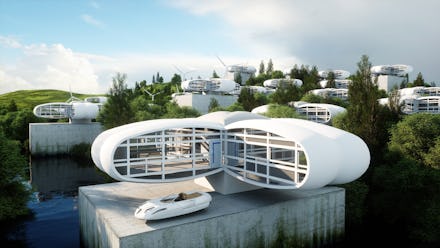What do future cities look like?

City planning in the 21st century often requires navigating a Pandora’s Box of complicated, interconnected issues. In population-dense urban centers like San Francisco, for example, strict zoning laws clash with a need for more housing. In contrast, further south in Los Angeles, an abundance of new construction has exacerbated the city’s growing population.
One common thread that connects city building across the national landscape is the slate of environmental concerns that arise with rampant urban development. Plans for a massive housing development in Los Angeles County have raised the ire of environmental activists, while spillover from San Francisco threatens roughly 300,000 acres of open space in the Bay Area.
This modern dilemma sees enterprising architects and urban planners focusing on futuristic solutions that address multiple issues simultaneously with an eye toward sustainability. In certain instances, this has come to mean innovation centered on two sources that have long fueled development: oil and natural gas. Initiatives powered by oil and natural gas are providing city builders on the cutting edge with actionable ways to usher in a new era of responsible urban development.
Much of the discussion around the city plan of tomorrow focuses on renewable energy, from Vermont’s 100% renewable energy city to San Jose’s commitment to solar energy. As Ted Nordhaus, an environmental policy expert and co-founder of the Breakthrough Institute, notes, those ideas are actually intrinsically linked to oil and natural gas. “Renewables today depend increasingly on natural gas for backup when the sun isn’t shining and the wind isn’t blowing,” he said in an interview. “So without natural gas or other forms of fossil energy, there would be little, if any, solar or wind energy anywhere.”
Oil is also an integral part of one of the most promising innovations in design and construction: 3-D printing. Forward-thinking companies like Adidas already use 3-D printing technology for both consumer-facing and business-to-business products. Meanwhile, architects are applying the technology to create entire homes from a variety of materials, including plastics derived from oil. Compared to traditional development, 3D-printed homes have minimal environmental impact: an estimated three to five pounds of waste per square foot is produced during the construction of a typical home, but 3-D printing reduces that waste considerably. The process also allows for flexibility in design based on local climate, the tenant’s needs and aesthetic demands, as demonstrated by the freeform 3D-printed house concept by Chicago-based architects WATG.
3-D printing is garnering attention from the U.S. government, too. Skidmore, Owings & Merrill, a prominent architecture firm, developed a 3D-printed housing project alongside the Department of Energy’s Oak Ridge National Laboratory. The project connects a specially designed housing pod to a hybrid electric vehicle powered by natural gas that serves as the energy source for the pod’s kitchen and lighting.
More traditional methods of home construction in future cities are ripe for environmentally friendly revisions. Cities like Chicago, London, Vancouver and Stockholm are experimenting with the idea of wooden skyscrapers and residential towers in place of steel and concrete. The concept of a wooden building is based on the use of cross-laminated timber. More commonly known as CLT, the material is an ultra-durable form of layered wood that’s been bonded together by an adhesive glue commonly derived from oil. Oil is also a component in the precision cutting fluids used during CLT manufacturing. CLT is a renewable resource, produces minimal waste, aids in the removal of carbon dioxide from the atmosphere and can be made in America, eliminating the carbon footprint associated with shipping it across long distances.
Even buildings made of steel and concrete — both of which are becoming more energy-efficient due to increased use of natural gas in their production — can be greened for future cities. Increasingly, that means incorporating plant life directly into the structure. This not only offsets the carbon production from building the structure itself, as plants take in carbon dioxide, but also saves on land use. By building “vertical gardens” up the sides of buildings or on rooftops, sustainability-minded developers can insert green space into overdeveloped districts or neighborhoods regardless of access to open areas for new builds. Famous examples include Milan’s renowned “Vertical Forest” residences and the planned towers in Nanjing, China, both designed by architect Stefano Boeri. These structures are not only appealing for their aesthetics, but also for their attempts to reverse the effects of smog pollution.
Other innovators are taking the concept even further by designing skyscrapers that function as urban farms that maximize growing area in places where fields for harvesting vegetables don’t exist. As this version of sustainability takes hold globally, the role of oil is often underscored. “Oil, natural gas and coal provide the overwhelming share of energy necessary to manufacture solar panels, wind turbines, batteries and most other sustainable technologies,” Nordhaus said. He added that using synthetic fertilizer, an oil byproduct, can be a more environmentally friendly way to attend to plant growth: “Synthetic fertilizer in some cases may be carbon negative even though it is made with fossil fuels, because it saves more carbon by avoiding the conversion of forests for agriculture than is created in the process of manufacturing fertilizer.”
As we move toward sustainability in urban development, many current strategies require oil and natural gas, particularly “when the sun isn’t shining and the wind isn’t blowing.” Environmental policy experts like Nordhaus will tell you that the best possible solutions often combine time-tested resources with smart, exciting innovations that ensure the cities we build tomorrow will survive for many years to follow. “Despite the hype about renewable energy and electric vehicles, the age of fossil fuels is far from over,” Nordhaus said. “The question is not whether cities will depend on fossil fuels, but how much they will depend on them, for how long.”